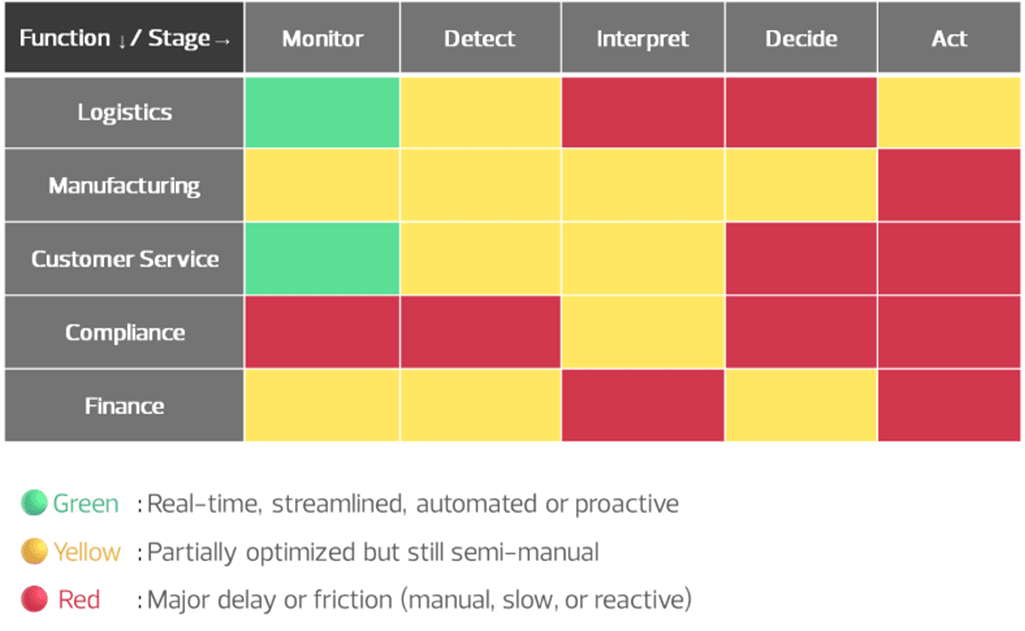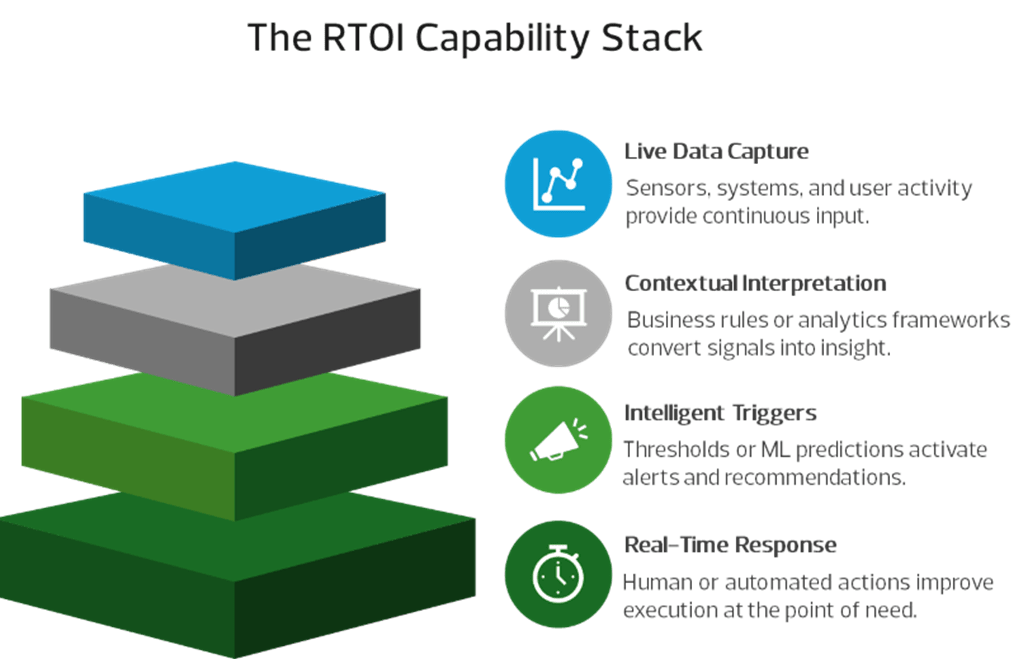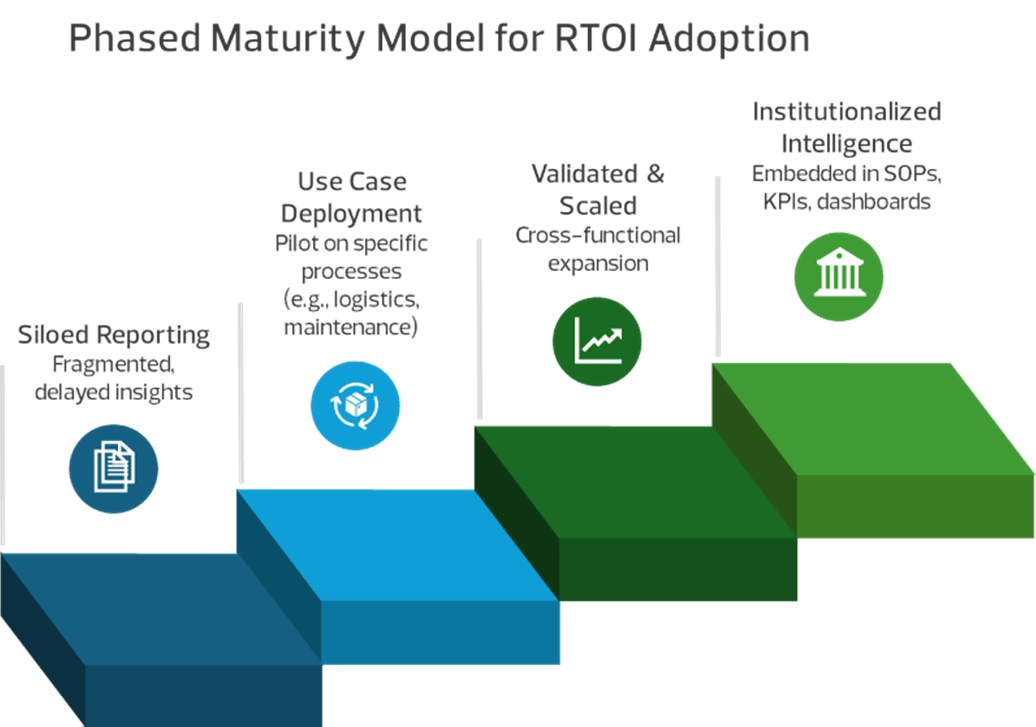The Board Demands Agility. Your Dashboard Tells You What Happened Yesterday.
That disconnect is where many organizations falter. Despite growing digital investments in dashboards and reporting tools, decision-making remains reactive, siloed, and too slow for the pace of today’s business environment.
In an era where minutes can mean millions, visibility is no longer enough. Leaders need to know not just what happened—but what is happening now, and what should be done next. Organizations that fail to make this shift risk falling behind more adaptive competitors. This is where Real-Time Operational Intelligence (RTOI) becomes essential: a structured capability that enables companies to sense operational signals, interpret them with context, and respond with speed and precision.
Data is Everywhere, But Action Is Still Too Late

Over the past decade, enterprises have significantly improved their access to operational data. Most have implemented systems for reporting, analytics, and performance tracking. Dashboards are widespread. Automation is increasing. Cloud platforms are modernizing data pipelines.
Yet in practice, many organizations still struggle to act in time. Data may be available, but it's often fragmented, delayed, or unclear in meaning. Frontline teams are overwhelmed with notifications, but under-informed about what actions to take. Meanwhile, key decisions—whether to reroute a shipment, shut down a production line, or reallocate customer support—arrive too slowly or not at all.
The result is a cycle of observation without orchestration, where visibility exists but fails to produce real-time responsiveness.
A manufacturing unit initiates maintenance after equipment failure, not before.
A retail store is overwhelmed by unexpected customer traffic because demand forecasts didn’t
trigger timely staffing adjustments.
Operational Lags Create Strategic Risk
Information delays aren't just operational inefficiencies—they create strategic vulnerabilities. Consider these recurring scenarios:
- A logistics team detects a cold chain failure only after goods are spoiled.
- A manufacturing unit initiates maintenance after equipment failure, not before.
- A retail store is overwhelmed by unexpected customer traffic because demand forecasts didn’t trigger timely staffing adjustments.
These aren’t edge cases. They’re daily occurrences in organizations that operate with backward-looking visibility, instead of forward-driving intelligence.
As operations become more distributed, digital, and customer-centric, the margin for delayed action narrows. The cost of inaction rises. And the complexity of decision-making multiplies.
What’s needed is not more data—but better timing, better context, and better execution.
Real-Time Operational Intelligence as a Strategic Lever
RTOI addresses this challenge by embedding intelligence into the rhythm of daily operations. It transforms the way organizations monitor, interpret, and act on operational data.
RTOI is not a dashboard, tool, or report. It is a systemic capability combination of:

Together, these elements create a closed feedback loop that enables proactive operations, not just reactive response.
Retail Workforce Management
A retail chain analyzed real-time foot traffic and sales telemetry to dynamically adjust in-store staffing. Result: a 25% drop in customer waiting times and 12% reduction in overtime costs.
The examples show that RTOI is a tangible operational shift that delivers measurable results.

How to Get Started
Organizations do not need to launch enterprise-wide transformations to begin reaping the benefits of operational intelligence. A phased, strategic approach allows for early wins and sustainable scale.
1. Discovery: Identify pain points where decision delays are costly. Focus on specific bottlenecks in logistics, production, or customer service.
2. Use Case Definition: Select a high impact use case where real-time signals and responses could materially improve performance.
3. Pilot and Validation: Develop a prototype and measure impact. Track speed of response, efficiency gains, and user adoption.
4. Scale and Integration: Expand the solution across other functions or geographies. Standardize architecture and governance for consistency.
5. Institutionalization: Embed the intelligence layer into operating procedures, dashboards, KPIs, and frontline workflows.
In today’s dynamic business environment, moving from visibility to velocity is essential for organizations seeking measurable and lasting impact. By embedding real-time operational intelligence into core workflows—grounded in strategy, data, and governance—businesses can respond faster, operate more efficiently, and manage risks more effectively. The path forward lies in building intelligence that’s not just visionary, but actionable and tailored to the realities of each organization.
By Resdy benyamin, Technology Consulting Practice

